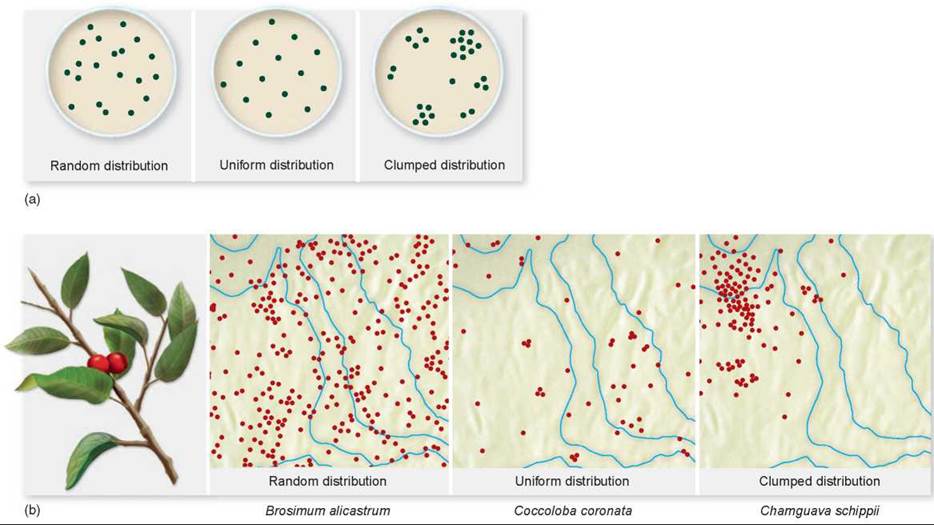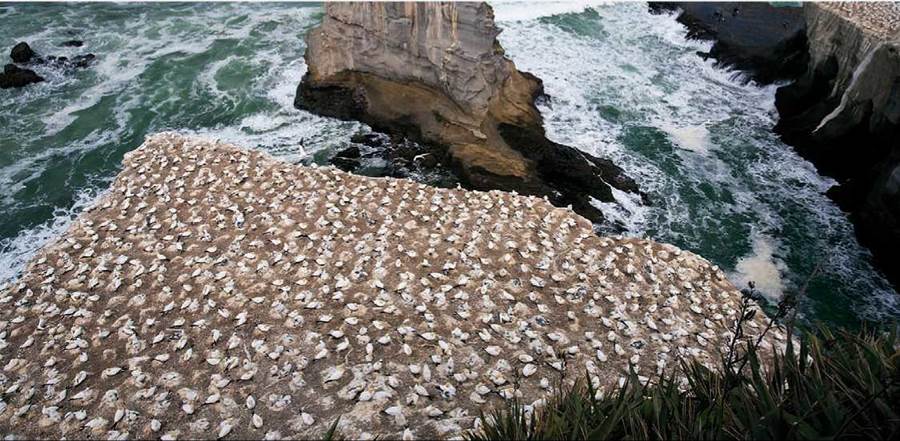THE LIVING WORLD
Unit Eight. The Living Environment
35. Populations and Communities
35.3. Population Distribution
A key characteristic affecting a species’ range is the way in which individuals of its populations are distributed. They may be randomly spaced, uniformly spaced, or clumped (figure 35.7).
Randomly Spaced
Individuals are randomly spaced within populations when they do not interact strongly with one another or with nonuniform aspects of their environment. Random distributions are not common in nature. Some species of trees, however, appear to exhibit random distributions in Panamanian rainforests (figure 35.7b).

Figure 35.7. Population distribution.
The different patterns of spacing are exhibited by (a)different arrangements of bacterial colonies and (b) three different species of trees from the same locality in Panama.
Source: Data from Elizabeth Losos, Center for Tropical Forest Science, Smithsonian Tropical Research Institute.
Uniformly Spaced
Uniform spacing within a population may often, but not always, result from competition for resources. The means by which it is accomplished, however, varies.
In animals, uniform spacing often results from behavioral interactions, such as those seen in figure 35.8. In many species, individuals of one or both sexes defend a territory from which other individuals are excluded. These territories provide the owner with exclusive access to resources such as food, water, hiding refuges, or mates, and individuals tend to be evenly spaced across the habitat. Even in nonterritorial species, individuals often maintain a defended space into which other animals are not allowed to intrude.

Figure 35.8. Uniform distribution in a population of gannets in New Zealand.
Among plants, uniform spacing also is a common result of competition for resources (figure 35.7b). In this case, however, the spacing results from direct competition for the resources. Closely spaced individual plants will compete for available sunlight, nutrients, or water. These contests can be direct, as when one plant casts a shadow over another, or indirect, as when two plants compete by extracting nutrients or water from a shared area. In addition, some plants, such as creosote, produce chemicals in the surrounding soil that are toxic to other members of their species. In all of these cases, only plants that are spaced an adequate distance from each other will be able to coexist, leading to uniform spacing.
Clumped Spacing
Individuals clump into groups or clusters in response to uneven distribution of resources in their immediate environments (see figure 35.7b). Clumped distributions are common in nature because individual animals, plants, and microorganisms tend to prefer microhabitats defined by soil type, moisture, or other aspects of the environment to which they are best adapted.
Social interactions also can lead to clumped distributions. Many species live and move around in large groups, which go by a variety of names (for example, flock, herd, pride). Such groupings can provide many advantages, including increased awareness of and defense against predators, decreased energetic cost of moving through air and water, and access to the knowledge of all group members.
At a broader scale, populations are often most densely populated in the interior of their range and less densely distributed toward the edges. Such patterns usually result from the manner in which the environment changes in different areas. Populations are often best adapted to the conditions in the interior of their distribution. As environmental conditions change, individuals are less well-adapted, and thus densities decrease.
The Human Effect
By altering the environment, humans have allowed some species, such as coyotes, to expand their ranges and move into areas they previously did not occupy. Moreover, humans have served as an agent of dispersal for many species. Some of these transplants have been widely successful, as discussed in more detail in chapter 38. For example, 100 starlings were introduced into New York City in 1896 in a misguided attempt to establish every species of bird mentioned by Shakespeare. Their population steadily spread such that by 1980, they occurred throughout the United States. Similar stories could be told for countless numbers of plants and animals, and the list increases every year. Unfortunately, the success of these invaders often comes at the expense of native species, as discussed further in chapter 38.
Dispersal Mechanisms
Dispersal to new areas can occur in many ways. Lizards, for example, have colonized many distant islands, probably due to individuals or their eggs floating or drifting on vegetation. Bats are often the only mammals on distant islands because they can fly to them. Seeds of many plants are designed to disperse in many ways. Some seeds are aerodynamically designed to be blown long distances by the wind. Others have structures that stick to the fur or feathers of animals, so that they are carried long distances before falling to the ground. Still others are enclosed in fleshy fruits. These seeds can pass through the digestive systems of mammals or birds and then germinate at the spot upon which they are defecated. Finally, seeds of Arceuthobium are violently propelled from the base of the fruit in an explosive discharge. Although the probability of long-distance dispersal events leading to successful establishment of new populations is slim, over millions of years, many such dispersals have occurred.
Key Learning Outcome 35.3. The distribution of individuals within a population can be random, uniform, or clumped and is determined in part by the availability of resources.